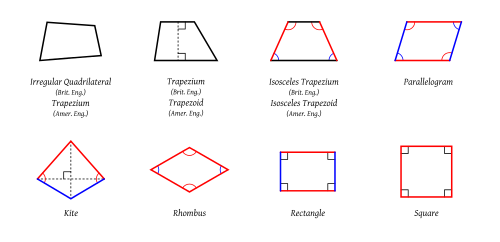Difference Between Parellelogram and Quadrilateral
A parallelogram is a two-dimensional structure that has four sides, of which the sides that are opposite are also parallel and of the same length. A quadrilateral is a two-dimensional structure that always has four sides and four corners

What is Parellelogram?
Definition of Parellelogram:
A parallelogram is a two-dimensional geometrical structure that is made of four sides, of which the sides that are opposite are also parallel and of the same length.
Properties:
The parallelogram is a geometrical two-dimensional shape, which is named for the fact that it has opposite parallel sides. A parallelogram can be divided into two triangles that are congruent, and the alternating interior angles formed by the line dividing the object into triangles, are equal. The sides that are corresponding of the two separate triangles will also be of equal length. The opposite angles of the parallelogram will also be the same. Both the sides and the angles that are opposite in a parallelogram will thus be equal. This is proved by virtue of the triangles and resulting findings. The successive angles of a parallelogram add up to 180 degrees. In other words, they are supplementary angles. If diagonal lines are drawn in a parallelogram, they will divide each other in half (i.e. bisect each other).
Types of parallelograms:
There is more than one type of parallelogram, and in fact, a rectangle, a rhombus, and a square are all types of parallelograms. A rectangle has two short sides and two longer sides, while a square has all four sides that are the same length.
Examples from the real world:
There are many examples of parallelograms in the real world. A laptop computer and a book are both examples of everyday objects that have this shape. A square or rectangular wall or table is also an example of a parallelogram.

What is Quadrilateral?
Definition of Quadrilateral:
A quadrilateral is a two-dimensional geometrical structure that always has four sides and four corners. A quadrilateral is also frequently called a polygon that has four sides. The part of the term “quad” means four.
Properties:
There are many different types of quadrilaterals that can be found. Each of these quadrilaterals has their own specific set of properties that further characterize and define the shape. The sum of all the angles that are found inside (interior) of a simple quadrilateral all adds up to 360 degrees. Opposite sides may or may not be equal in length depending on what type of quadrilateral we are concerned with. A square, for instance, would have sides that are all the same length, but a rectangle would not. Similarly, opposite sides of the quadrilateral may or may not be parallel. A rectangle, rhombus and square all have parallel opposite sides, but a kite does not have any opposite parallel sides at all. In fact, all parallelograms can also be characterized as being types of quadrilateral shapes. Some quadrilaterals are called complex structures because the sides cross over to form unusual shapes.
Types of quadrilaterals:
There are several geometric shapes that can be classified as types of quadrilaterals. In fact, all parallelograms are also classified as being quadrilaterals since they have four sides. This means that a rhombus, square and rectangle are quadrilaterals. In addition to these shapes, a trapezoid and kite are also types of quadrilaterals.
Examples from the real world:
There are several examples of quadrilaterals from everyday life. A square table or a rectangular wall of a house, are shapes that are quadrilateral. A kite that somebody flies is also a quadrilateral. There are many more examples of quadrilaterals than there are of parallelograms because the opposite sides do not need to be parallel. The shape simply has to have four corners and four sides.
Difference between Parallelogram and Quadrilateral
-
Definition
A parallelogram is a two-dimensional geometric structure that always has four sides, of which opposite sides are the same length, and parallel. A quadrilateral is simply a two-dimensional structure that has four sides to it.
-
Parallel sides
In a parallelogram there is always a pair of sides that are opposite that are parallel. In a quadrilateral, there are only sometimes parallel sides present, and at other times opposite sides are never parallel.
-
Opposite sides of equal length
A shape that is a parallelogram always has opposite sides that are of the same length. A shape that is a quadrilateral does not always have sets of opposite sides that are of the same length, sometimes they are not equal length.
-
Opposite angles of equal size
A parallelogram is a shape in which the opposite angles are always of equal size. A quadrilateral is a shape in which the opposite angles are sometimes, but not always of equal size.
-
Types
The following geometric shapes are all also classified as being types of parallelograms: square, rhombus, and rectangle. Geometric shapes that can be classified as being quadrilaterals include the square, rectangle, rhombus, trapezoid, kite and an assortment of complex shapes.
Table comparing Parallelogram and Quadrilateral

Summary of Parallelogram Vs. Quadrilateral
- A parallelogram is a geometrical shape in which the opposite sides are not only the same length, but are also parallel to each other.
- A quadrilateral is any geometrical shape that is comprised of four sides and four corners.
- Parallelograms are all quadrilaterals, but not all quadrilaterals are parallelograms.
- A parallelogram always has opposite sides that are of equal length and are in fact parallel to each other.
- There are more types of quadrilaterals than there are types of parallelograms because the definition of a quadrilateral is more general.
- Difference Between Rumination and Regurgitation - June 13, 2024
- Difference Between Pyelectasis and Hydronephrosis - June 4, 2024
- Difference Between Cellulitis and Erysipelas - June 1, 2024
Search DifferenceBetween.net :
Leave a Response
References :
[0]Image credit: https://upload.wikimedia.org/wikipedia/commons/thumb/4/41/Parallelogram.svg/500px-Parallelogram.svg.png
[1]Image credit: https://upload.wikimedia.org/wikipedia/commons/thumb/6/68/Quadrilaterals.svg/500px-Quadrilaterals.svg.png
[2]Burzynsky, Danny, Wade Ellis. Fundamentals of Mathematics. Houston: Rice University, 2019.
[3]Levy, Silvio. “Quadrilaterals.” The Geometry Center Home Page. University of Illinois at Urbana, 2000, http://www.geom.uiuc.edu/docs/reference/CRC-formulas/node23.html
[4]Wolfram Research Inc. “Parallelogram.” Wolfram Mathworld. Wolfram Mathworld, 2019, http://mathworld.wolfram.com/Parallelogram.html
